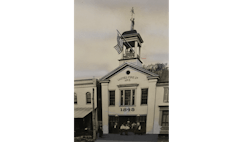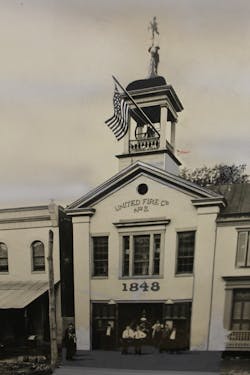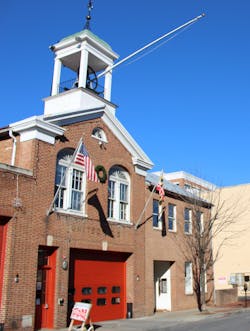In 2023, the quarters of the United Steam Fire Engine Company #3 in Frederick, MD, celebrates 175 years of continuous operation. Although the interior of the building was upgraded since 1848 and an expanded engine bay was added in the 1960s, the original part of the building still is used as a functional engine bay.
Beginnings
The United Fire Company was organized in 1845. It took over the engine house of the former Washington Hose Company, which was located on East All Saints Street near Carroll Creek in the center of Frederick. (The Washington Hose Company was organized in 1837 but failed to maintain membership.)
Although the new company initially called itself the Mechanics Hose Company, a meeting of the company in November 1845 voted to change the name to the United Hose Company. Meetings for the United Hose Company were held at the East All Saints Street location until a new firehouse was built.
In 1846, the minutes of the United Hose Company (known as the United Fire Company by 1851) note that the fire company effected the exchange of the former Washington Hose Company building and petitioned the city of Frederick for funds to buy an engine, purchase a lot and erect a new engine house on Market Street. Within a year, the city provided $430 to purchase a lot. The fire company also provided $50 toward the new location.The new building was built in 1848 in a rather swampy area of Frederick on South Market Street near East All Saints Street, less than a block from the old firehouse.
The fire company members were nicknamed “Swampers” even before the new firehouse was built. An entry on July 26, 1846, in the diary of Jacob Engelbrecht (which served as a first-party account of daily activities in Frederick) notes the response to a fire at Dr. William Bradley Tyler’s stable: “… the Swamp Rangers were there first with their hose and put it out.” The fact that the location of the new firehouse was even closer to the banks of Carroll Creek only served to enhance the nickname Swampers. The new fire station was dubbed by the locals as “Swamp Hall.”
The firehouse was a brick structure that was 60 feet deep off of the street. A cupola that included a large bell, which was nicknamed the “Swamp Bell,” was built on the top of the structure to enable the fire company to summon members for an alarm of fire.
Because of the close proximity of the firehouse to Carroll Creek and the moisture-laden ground that surrounded the firehouse, flooding became an issue. The Great Flood of 1868 not only destroyed many structures in downtown Frederick but also swept away all of the fire company records.
The fire company ordered a new constitution to be drafted and adopted.
It should be noted that the Swamp Bell also was used to warn local citizens of dangerous flooding of Carroll Creek. Ironically, a little bit more than 100 years later, in 1976, another catastrophic flood occurred, which caused significant damage to the fire station.
Beyond firefighting
The United Fire Company as well as the other two fire companies in Frederick went above and beyond the call of duty when each one organized home guard militia units. The first militia unit was the United Guards, which was organized in 1858 by Capt. John Sinn of the United Fire Company. The unit was given permission to keep “army accoutrements” in the gallery of the fire hall.
The other two Frederick fire company militia units were the Independent Rifles (or Riflemen) of the Independent Hose Company and the Junior Defenders of the Junior Fire Company.
These three fire company militia units were called into action on Oct. 17, 1859.
(According to Engelbrecht’s diary, on Oct. 17, 1859, at 10 a.m., “The Independent Bell and the United, or Swamp, Bell are both now ringing (Swamp Bell first), calling together the military companies of our city.”
On Oct. 17, 2009, Lt. John Arnold of the United Steam Fire Engine Company No. 3 rang the bell at exactly 10 a.m. to recreate the event.)
The three units responded to Harpers Ferry to help to quell an insurrection, John Brown’s raid. After the marines, who were led by Robert E. Lee, captured Brown and his men, Sinn and the United Guards were utilized to guard the engine house where the insurrectionists were held.
Frederick firehouses also were used for military purposes during the Civil War. The United Fire Company firehouse was used as an arsenal; the Junior Fire Company firehouse was used as part of General Hospital No. 6 during the Battle of Antietam as well as a stockade for Confederate prisoners.True to its origins
Swamp Hall essentially went unchanged for more than 100 years.
At times, the brick was painted.
Around 1920, an archway-style apparatus bay door replaced the original wooden doors. The arched doorway included a number “3” in the brick keystone.
Two small entrance doors were added for pedestrian access, leading directly to a set of stairs to enter the banquet hall.
Although a large apparatus bay addition was built onto the original structure in 1967, remnants of the horse stalls remained.
Tile floors replaced wooden flooring, and offices now subdivide the social hall that hosted events.
However, the bottom line is that the basic structure of the United Steam Fire Engine Company #3 houses apparatus and equipment that respond to incidents in 2023.
Rich legacy
Swamp Hall of the United Steam Fire Engine Company #3 saw the heroes of the United Guards return from Harpers Ferry carrying John Brown’s pikes. It saw Confederate and Union troops march past the firehouse. It witnessed catastrophic floods and civil disturbances.
The engine house was the quarters of early hand pumpers that were pulled by people and massive steam pumpers that were pulled by horses that were named Doc, Dud, Jody and Swamp.
Swamp Hall stands as a testament to the early days of firefighting in Frederick. An argument can be made that it’s the oldest continuously operating fire station in America.
About the Author

Clarence Jewell
Clarence “Chip” Jewell is in his 54th year as an active volunteer. He is a life member of the Libertytown, MD, Volunteer Fire Department and the Junior Fire Co. No. 2 in Frederick, MD. Jewell retired in 2017 as the deputy chief/director of the Frederick County, MD, Division of Volunteer Fire & Rescue Services, a combination service that consists of 25 independent fire and rescue companies, 600 operational volunteers, 1,700 volunteers and more than 400 career personnel. He has a bachelor's degree in fire science from the University of Maryland/University College. Jewell is a management-level instructor for the Maryland Fire and Rescue Institute. He is active on several committees of the Maryland State Firemen’s Association.


